- Overview
- Spotlight
- Photos
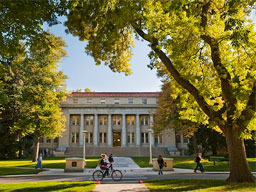
In 1870, the Territorial Legislature passed a bill that created the Colorado Agricultural College, now known as Colorado State University. The signing of this bill by the Territorial Governor, Edward McCook, built on a national piece of legislation passed by the U.S. Congress and signed by President Abraham Lincoln in 1862 to provide grants of public land to establish colleges. Unfortunately, no funding was allotted to the group of appointed trustees to purchase and manage the property, erect buildings, establish governance, and build buildings. The future of Colorado State did not look promising during the nine years after the passing of the bill to establish an agricultural college in Fort Collins to the time the school enrolled its first five students.
The citizens of Fort Collins, however, took things into their own hands. In 1871, Robert Dazell deeded 30 acres of land for a college site, and in 1872 the Larimer County Land Improvement Company contributed another 80 acres. In 1874, the Territorial Legislative Assembly finally allocated $1,000 to aid in constructing college buildings, and even that sum required the college trustees to come up with a matching amount. Again it was local folks, businesses, and organizations such as the Grange that gathered those matching funds. Citizens also plowed and seeded 20 acres of wheat, followed by the building of a 16-foot-by-24-foot red brick structure known as the "Claim Shanty." These efforts helped to inspire further work towards the school for farmers’ sons and daughters, while proving the good faith on the part of those who wanted a college in Fort Collins. The cornerstone for the first official building, Old Main, was set July 27, 1878, with the opening of the Colorado Agricultural College taking place in the fall of 1879.
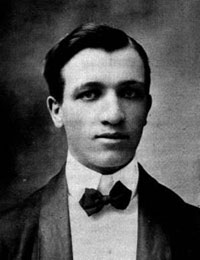
In the drylands of the plains of Colorado, a place where water is as valuable as gold, a device is needed to accurately measure a farmer's legal share of water. The Parshall flume, invented by Ralph L. Parshall at Colorado State University's hydrology lab in 1921, does just that.
The Parshall flume measures water flow in an open channel (such as an irrigation canal) by narrowing the channel to a fixed size. Measuring the water pressure before and after the water passes through the opening determines the rate of flow. The Parshall flume became the standard water measuring device used throughout the world.
It is difficult to overstate the significance of the contribution of Colorado State University to the life and economy of Fort Collins and the rest of the world. Parshall graduated from CSU in 1904 and later served on the faculty. He developed the flume during his 35-year career with the USDA's Office of Irrigation Investigations, stationed at CSU. You can find out more about Ralph Parshall and his flume in this online exhibit in the Water Resources Archive at CSU.
Click any of the green pins on the map to see visitor information about that site.
Download a printable version of Tour 3 complete with directions, maps, and activities.
Open this tour in Google Earth by downloading the KML version of this map.
See what's going on today at Colorado State University.
Soapstone Prairie Natural Area
- Managing Agency
- City of Fort Collins Natural Areas Program
- Open
- March 1 to December 1. Some trails closed seasonally for wildlife protection.
Soapstone Prairie offers a remote, backcountry experience. Emergency response can take an hour or more. Be prepared! Start early in the day, plan for the weather and carry a trail map. Bring more than enough water, food and clothing. Cell phone service is not reliable, but there is an emergency call box at the entrance station. This is rattlesnake country so watch where you put your hands and feet and stay on established trails.
Pronghorn at Soapstone
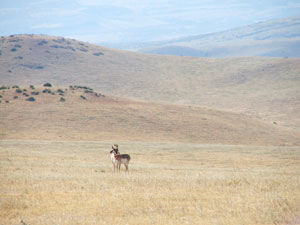
photo by Terry Burton
Museo de las Tres Colonias
- Location
- 425 10th St. Fort Collins
- Hours
- 12:30 to 3:00 pm on the third Saturday each month
- Cost
- Free
Designated as a Fort Collins Local Landmark in 2001, the former family home of John and Inez Romero now serves as a regional interpretive center that recognizes the contributions of the Hispanic community in achieving Northern Colorado ’s spectacular growth and development.
For more information, visit the Museo's website at http://museodellastrescolonias.org/Museo/Museo.html.
The Romero House
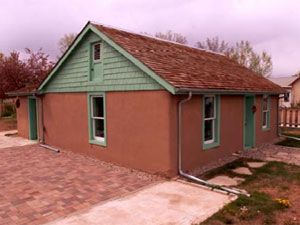
Photo courtesy of Poudre Landmarks Foundation
Colorado State University
- University Welcome Center
- Located in Ammon Hall (see map). Academic year hours: 7:45 - 4:45. Summer hours: 7:30 - 4:30
- Maps
- For a campus map, click here
- For a map of parking areas, click here
The Welcome Center at Ammon Hall is the university's official front door for visitors. The center offers general information about campus and the Fort Collins community, along with admissions information for prospective students and their families, including daily information sessions and campus tours.
For more information on planning your visit, see the Colorado State University website at www.colostate.edu/
Ammons Hall on the CSU Oval
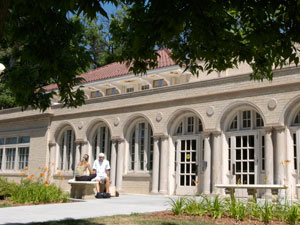
photo courtesy of Colorado State University
Cathy Fromme Prairie Natural Area
- Managing Agency
- City of Fort Collins Natural Areas Program
- Open
- 5:00 am - 11:00 pm
- Trails
- The paved Fossil Creek Trail is 2.5 miles one way.
- Parking
- Located at Shields Street (s. of Harmony) and Fromme Prairie Way (from Harmony take Seneca s. to Fromme Prairie Way).
Cathy Fromme Prairie is a rare example of Fort Collins’ pre-settlement shortgrass prairie landscape. Prairie dog colonies here support bald eagles and hawks. Horned lizards, ground-nesting songbirds, butterflies, rabbits, coyotes and rattlesnakes also can be seen. The raptor observatory, built into the hillside near the Shields Street entrance, is an excellent place from which to watch hawks and eagles, especially in winter. Educational activities are offered from May - October.
Fossil Creek Trail
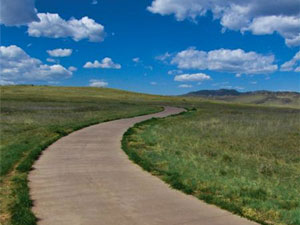
photo by Ryan Burke


